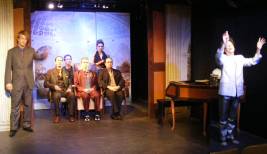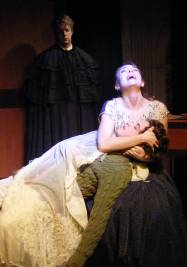
For the past several years, August Viverito and T L Kolman have been stripping down big stage, big budget Broadway productions to their brilliant essentials on the matchbox stage of the Chandler Studio Theatre in North Hollywood. Now, to the ranks of their superb downscalings of M Butterfly, Equus, and Sweeney Todd can be added The Production Company’s equally outstanding re-envisioning of Peter Shaffer’s Amadeus.
The original Broadway production of the Tony Award-winner for Best Play of 1981 featured a cast of 25, sumptuous 18th Century costumes, lavish sets, and powdered wigs galore. The ProdCo whittles the ensemble down to 7, dresses them in far simpler yet still stunning mid-20th Century garb, and gets straight to the heart and soul of Amadeus, the rivalry between Antonio Salieri, composer to the court of Austrian Emperor Joseph II, and his upstart competitor, Wolfgang Amadeus Mozart. It is Salieri’s realization that his own talents are nothing compared to the genius that is Mozart that drives the far less gifted man to seek his rival’s destruction, whatever the cost to his own sanity.
We first encounter Salieri in 1825 on the night of his death at age 74, three and a half decades after his nemesis’s untimely demise at 35. With the citizens of Vienna’s whispers of “Salieri” and “assassin” echoing in his ears, the Italian composer begins his confession to the audience, and soon we are back in the year 1781, on the night Salieri first crosses paths with Mozart in Vienna’s Schönbrunn Palace library. To our surprise, the Mozart we meet is not the musical savant we’re expecting but a big-haired, potty-mouthed man-child in pursuit of Constanze Weber, his landlady’s daughter—giggling, meowing, threatening to “pounce-pounce” and “scrunch-munch” and “chew-poo my little mouse-wouse.”
Salieri is appalled to his very core by such an infantile display, but this emotion pales in comparison to the awe he feels upon getting his first earful of Mozart’s musical gifts. Awe soon turns to envy, however, the seeds of hatred planted when young Wolfgang effortlessly transforms the “extremely banal” march Salieri has composed in his honor into something extraordinary. Later, in one of Amadeus’s most famous and powerful scenes, Salieri scans a stack of Mozart’s manuscripts, and both he and we hear the notes Mozart has put to paper and realize that we are in the presence of genius.
It is Salieri’s recognition that his first impressions of the young Austrian’s talent “had been no accident” that cause the embittered Italian to embark on a path which will send them both spiraling down into their own particular brand of hell.
Director Viverito’s imaginative vision combined with the proximity from which we observe Salieri and Mozart give this Amadeus an intimacy and power that bigger, more sumptuous productions may have lacked. Gone are most of the dozen or so courtiers, leaving behind only the Emperor, a Chancellor, a Count, and a Baron (who double as the court gossips aka the Venticelli), and Constanze. Making ingenious use of the set he has designed for the compact Chandler stage, Viverito keeps Amadeus visually varied from its dramatic start to its stunning denouement.
At the heart of any production of Amadeus are its two leads, enacting roles which have won awards and award nominations for many of the actors who have brought them to life since the play’s London premiere in 1979. Here the parts go to Peter Swander and Patrick Stafford, and it’s hard to imagine anyone better that this pair of superb performers.
Unlike the 50something actors (or actors who looked 50something) who’ve played Salieri before, the boyishly youthful Swander reminds us that Salieri and Mozart were not all that far apart in age. This is no old fogey competing with a young whippersnapper, but a man who still has the bloom of early life on his face. In Swander’s hands, this “also-ran” inspires audience empathy (or at least this reviewer’s), and the more eaten up with envy Salieri becomes, the more commanding Swander’s tour-de-force work grows.
He is matched every step of the way by the brilliant young Stafford, proving here that his acclaimed performance as Alan Strang in last year’s Equus was no fluke. As Wolfgang Amadeus Mozart, a character who shares nothing with Strang save the emotional intensity of the pair’s climatic scenes, Stafford is wildly (and appropriately) over-the-top in the composer’s early moments, and absolutely heartbreaking as the destroyed man this genius has become in his wrenching final scene opposite Salieri.
Danielle Doyen is so effervescent in her early scenes as Constanze that her powerful dramatic work in the second act is all the more striking. David Robert May is quite splendid as the preening yet oddly sympathetic Emperor Joseph II. The wonderful Dan Alemshah and David Stifel are subtle scene stealers as Count Orsini-Rosenberg and Chancellor Von Strack. (There does seem to be no clear explanation as to why Orsini-Rosenberg and Von Strack speak with foreign accents when no one else in the cast does—other than perhaps because they’re funnier that way.) Barry Saltzman completes the cast in fine fashion with an assured performance as the dastardly Baron Van Swieten.
Once again, Viverito’s set and lighting are textbook examples of intimate theater design at its best, as is Bob Blackburn’s sound. Shon LeBlanc’s costumes give the production a terrific, modern look without sacrificing the classy elegance that any Amadeus deserves. Viverito has been assisted in his directorial duties by Kolman.
Like The Production Company’s recent Copenhagen, this production has turned this reviewer from an Amadeus skeptic to a fan. Regular ProdCo ticket buyers have come to recognize the Viverito-Kolman stamp as a guarantee of quality intimate Los Angeles theater. Amadeus proves no exception.
The Production Company, Chandler Studio Theatre, 12443 Chandler Blvd., North Hollywood.
www.theprodco.com
–Steven Stanley
June 18. 2010





 Since 2007, Steven Stanley's StageSceneLA.com has spotlighted the best in Southern California theater via reviews, interviews, and its annual StageSceneLA Scenies.
Since 2007, Steven Stanley's StageSceneLA.com has spotlighted the best in Southern California theater via reviews, interviews, and its annual StageSceneLA Scenies.







 COPYRIGHT 2024 STEVEN STANLEY :: DESIGN BY
COPYRIGHT 2024 STEVEN STANLEY :: DESIGN BY